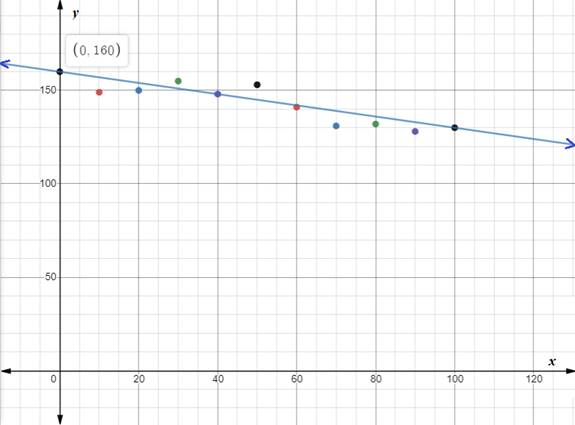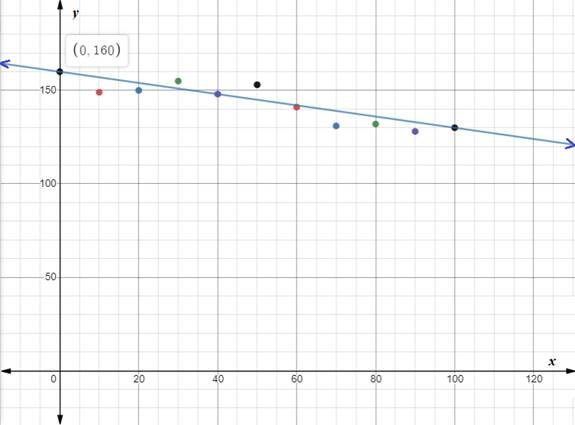
Concept explainers
a.
To make:
A
a.
Answer to Problem 33E
The line of best fit would look like:

Explanation of Solution
Given:
The table below shows the men’s winning timesin the Boston Marathon for every tenth year from 1900 to 2000. In the table, x represents the number of years since 1900, and y represents the corresponding winning time (to the nearest minute).

Calculation:
First of all, we will write our given data as ordered pairs
Now we will plotour given values on coordinate plane and draw a line of best fit as shown below:

b.
To write:
An equation for the line of best fit.
b.
Answer to Problem 33E
The equation for the line of the best fit would be
Explanation of Solution
Given:
The table below shows the men’s winning times in the Boston Marathon for every tenth year from 1900 to 2000. In the table, x represents the number of years since 1900, and y represents the corresponding winning time (to the nearest minute).

Calculation:
First of all, we will find slope of line passing through point (0,160) and (100,130) as:
Now we will use slope-intercept form to write our equation as:
Therefore, the equation for the line of the best fit would be
c.
To predict:
The men’s winning time in the Boston Marathon for the year 2010.
c.
Answer to Problem 33E
Men’s winning time in the Boston Marathon for the year 2010would be 127 minutes.
Explanation of Solution
Given:
The table below shows the men’s winning times in the Boston Marathon for every tenth year from 1900 to 2000. In the table, x represents the number of years since 1900, and y represents the corresponding winning time (to the nearest minute).

Calculation:
To predict men’s winning time in the Boston Marathon for the year 2010, we will substitute
Therefore, men’s winning time in the Boston Marathon for the year 2010 would be 127 minutes.
d.
Do you think your equation will accurately predict winning times far into the future? Explain your reasoning.
d.
Answer to Problem 33E
The equation will not accurately predict winning times far into the future.
Explanation of Solution
Given:
The table below shows the men’s winning times in the Boston Marathon for every tenth year from 1900 to 2000. In the table, x represents the number of years since 1900, and y represents the corresponding winning time (to the nearest minute).

Calculation:
The line of best fit is for our given data. The slope of the line is negative, so as the x values will increase the value of y will approach zero. Our equation for the line of best fit can predict winning times close to year 2000.
Since we cannot expect all data points to fall on the line of best fit, therefore, the equation will not accurately predict winning times far into the future.
Chapter 8 Solutions
ELEMENTARY+INTERMEDIATE ALGEBRA
Additional Math Textbook Solutions
Introductory Statistics
College Algebra (7th Edition)
Precalculus
Basic Business Statistics, Student Value Edition
Calculus: Early Transcendentals (2nd Edition)
A Problem Solving Approach To Mathematics For Elementary School Teachers (13th Edition)
- 1. Given that h(t) = -5t + 3 t². A tangent line H to the function h(t) passes through the point (-7, B). a. Determine the value of ẞ. b. Derive an expression to represent the gradient of the tangent line H that is passing through the point (-7. B). c. Hence, derive the straight-line equation of the tangent line H 2. The function p(q) has factors of (q − 3) (2q + 5) (q) for the interval -3≤ q≤ 4. a. Derive an expression for the function p(q). b. Determine the stationary point(s) of the function p(q) c. Classify the stationary point(s) from part b. above. d. Identify the local maximum of the function p(q). e. Identify the global minimum for the function p(q). 3. Given that m(q) = -3e-24-169 +9 (-39-7)(-In (30-755 a. State all the possible rules that should be used to differentiate the function m(q). Next to the rule that has been stated, write the expression(s) of the function m(q) for which that rule will be applied. b. Determine the derivative of m(q)arrow_forwardSafari File Edit View History Bookmarks Window Help Ο Ω OV O mA 0 mW ర Fri Apr 4 1 222 tv A F9 F10 DII 4 F6 F7 F8 7 29 8 00 W E R T Y U S D பட 9 O G H J K E F11 + 11 F12 O P } [arrow_forwardSo confused. Step by step instructions pleasearrow_forward
- In simplest terms, Sketch the graph of the parabola. Then, determine its equation. opens downward, vertex is (- 4, 7), passes through point (0, - 39)arrow_forwardIn simplest way, For each quadratic relation, find the zeros and the maximum or minimum. a) y = x 2 + 16 x + 39 b) y = 5 x2 - 50 x - 120arrow_forwardIn simplest terms and step by step Write each quadratic relation in standard form, then fi nd the zeros. y = - 4( x + 6)2 + 36arrow_forward
- In simplest terms and step by step For each quadratic relation, find the zeros and the maximum or minimum. 1) y = - 2 x2 - 28 x + 64 2) y = 6 x2 + 36 x - 42arrow_forwardWrite each relation in standard form a)y = 5(x + 10)2 + 7 b)y = 9(x - 8)2 - 4arrow_forwardIn simplest form and step by step Write the quadratic relation in standard form, then fi nd the zeros. y = 3(x - 1)2 - 147arrow_forward
- Step by step instructions The path of a soccer ball can be modelled by the relation h = - 0.1 d 2 + 0.5 d + 0.6, where h is the ball’s height and d is the horizontal distance from the kicker. a) Find the zeros of the relation.arrow_forwardIn simplest terms and step by step how do you find the zeros of y = 6x2 + 24x - 192arrow_forwardStep by step Find the zeros of each quadratic relation. a) y = x2 - 16xarrow_forward
 Algebra and Trigonometry (6th Edition)AlgebraISBN:9780134463216Author:Robert F. BlitzerPublisher:PEARSON
Algebra and Trigonometry (6th Edition)AlgebraISBN:9780134463216Author:Robert F. BlitzerPublisher:PEARSON Contemporary Abstract AlgebraAlgebraISBN:9781305657960Author:Joseph GallianPublisher:Cengage Learning
Contemporary Abstract AlgebraAlgebraISBN:9781305657960Author:Joseph GallianPublisher:Cengage Learning Linear Algebra: A Modern IntroductionAlgebraISBN:9781285463247Author:David PoolePublisher:Cengage Learning
Linear Algebra: A Modern IntroductionAlgebraISBN:9781285463247Author:David PoolePublisher:Cengage Learning Algebra And Trigonometry (11th Edition)AlgebraISBN:9780135163078Author:Michael SullivanPublisher:PEARSON
Algebra And Trigonometry (11th Edition)AlgebraISBN:9780135163078Author:Michael SullivanPublisher:PEARSON Introduction to Linear Algebra, Fifth EditionAlgebraISBN:9780980232776Author:Gilbert StrangPublisher:Wellesley-Cambridge Press
Introduction to Linear Algebra, Fifth EditionAlgebraISBN:9780980232776Author:Gilbert StrangPublisher:Wellesley-Cambridge Press College Algebra (Collegiate Math)AlgebraISBN:9780077836344Author:Julie Miller, Donna GerkenPublisher:McGraw-Hill Education
College Algebra (Collegiate Math)AlgebraISBN:9780077836344Author:Julie Miller, Donna GerkenPublisher:McGraw-Hill Education





